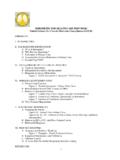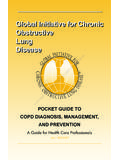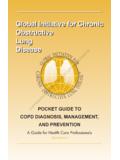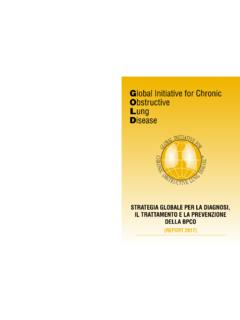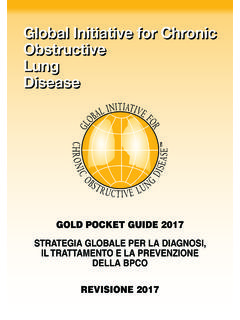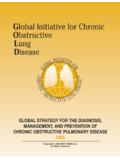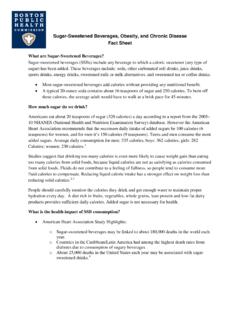Transcription of Global Initiative for Chronic Disease - goldcopd.org
1 Global Initiative for Chronic Obstructive Lung Disease TE. U. IB. TR. IS. D. R. O. PY. O. C. T. O. N. O. L-D. IA. RE. AT. M. D. TE. H. IG. R. PY. O. C. POCKET GUIDE TO. COPD DIAGNOSIS, MANAGEMENT, AND PREVENTION. A Guide for Health Care Professionals 2017 REPORT. Global Initiative FOR Chronic . OBSTRUCTIVE LUNG Disease . POCKET GUIDE TO COPD DIAGNOSIS, MANAGEMENT, AND PREVENTION. A Guide for Health Care Professionals 2017 EDITION. TE. U. IB. TR. IS. D. R. O. PY. O. C. T. O. N. O. D. L- IA. ER. AT. M. D. TE. H. IG. R. PY. O. C. 2017 Global Initiative for Chronic Obstructive Lung Disease , Inc. ii GOLD BOARD OF DIRECTORS (2016) GOLD SCIENCE COMMITTEE (2016). Alvar Agusti, MD, Chair Claus Vogelmeier, MD, Chair Hospital Cl nic, Universitat de Barcelona, Ciberes University of Marburg Barcelona, Spain Marburg, Germany Marc Decramer, MD, Chair (to 05/16) Alvar Agusti, MD.
2 University of Leuven Hospital Cl nic, Universitat de Barcelona, Ciberes, Leuven, Belgium Barcelona, Spain Bartolome R. Celli, MD Antonio Anzueto, MD. Brigham and Women's Hospital Boston, University of Texas Health Science Center Massachusetts, USA San Antonio, Texas, USA. Rongchang Chen, MD Peter Barnes, MD. Guangzhou Institute of Respiratory Disease National Heart and Lung Institute Guangzhou, PRC London, United Kingdom Gerard Criner, MD Jean Bourbeau, MD. Temple University School of Medicine McGill University Health Centre Philadelphia, Pennsylvania, USA Montreal, Canada Peter Frith, MD Gerard Criner, MD. Repatriation General Hospital, Adelaide Temple University School of Medicine South Australia, Australia Philadelphia, Pennsylvania, USA.
3 David Halpin, MD Leonardo M. Fabbri, MD. TE. Royal Devon and Exeter Hospital University of Modena & Reggio Emilia U. Devon, UK Modena, Italy IB. TR. M. Victorina L pez Varela, MD Fernando Martinez, MD. Universidad de la Rep blica Montevideo, University of Michigan School of Medicine IS. Uruguay D. Ann Arbor, Michigan, USA. R. Masaharu Nishimura, MD Nicolas Roche, MD. Hokkaido University School of Medicine Sapporo, O. H pital Cochin PY. Japan Paris, France O. C. Roberto Rodriguez-Roisin, MD Roberto Rodriguez-Roisin, MD. T. Hospital Cl nic, Universitat de Barcelona Thorax Institute, Hospital Clinic O. Barcelona, Spain Universitat de Barcelona N. Barcelona, Spain O. Claus Vogelmeier, MD. D. University of Gie en and Marburg Donald Sin, MD.
4 L- Marburg, Germany St. Paul's Hospital IA. Vancouver, Canada ER. GOLD PROGRAM DIRECTOR. AT. Rebecca Decker, MSJ Dave Singh, MD. University of Manchester M. Fontana, Wisconsin, USA. Manchester, UK. D. Suzanne S. Hurd, PhD (until 12/2015). TE. Vancouver, Washington, USA Robert Stockley, MD. H. University Hospital IG. Birmingham, UK. R. EDITORIAL ASSISTANCE. PY. Ruth Hadfield, PhD. J rgen Vestbo, MD. Sydney, Australia O. University of Manchester C. Manchester, England, UK. GOLD NATIONAL LEADERS. The GOLD Board of Directors is grateful to the many GOLD Jadwiga A. Wedzicha, MD. National Leaders who participated in discussions of University College London concepts that appear in GOLD reports. London, UK. INVITED CONTRIBUTORS.
5 Prof. Richard Beasley, NZ; Peter M A Calverley, MD, UK;. Ciro Casanova, MD, Spain; James Donohue, MD, USA;. MeiLan Han, MD, USA; Nicola Hanania, MBBS, USA;. Maria Montes de Oca, MD,Venezuela; Takahide Nagase, MD, Japan; Alberto Papi, MD, Italy; Ian Pavord, MD, UK;. David Price, FRCGP, UK.. Disclosure forms for GOLD Committees are posted on the GOLD Website, iii TABLE OF CONTENTS. TABLE OF CONTENTS .. IV Oxygen therapy and ventilatory support .. 18. Global STRATEGY FOR THE DIAGNOSIS, MANAGEMENT OF STABLE COPD .. 20. MANAGEMENT, AND PREVENTION OF COPD .. 1. OVERALL KEY POINTS: .. 20. INTRODUCTION .. 1 IDENTIFY AND REDUCE EXPOSURE TO RISK. FACTORS .. 20. DEFINITION AND OVERVIEW .. 1. TREATMENT OF STABLE COPD.
6 21. OVERALL KEY POINTS: .. 1 PHARMACOLOGIC 21. WHAT IS Chronic OBSTRUCTIVE PULMONARY 2 Pharmacologic treatment algorithms .. 23. Disease (COPD)? .. 2 MONITORING AND FOLLOW-UP .. 25. WHAT CAUSES COPD? .. 2. MANAGEMENT OF EXACERBATIONS .. 26. DIAGNOSIS AND ASSESSMENT OF COPD .. 4. OVERALL KEY POINTS: .. 26. TE. OVERALL KEY POINTS: .. 4. U. TREATMENT OPTIONS .. 27. IB. DIAGNOSIS .. 4 Treatment 27. TR. DIFFERENTIAL DIAGNOSIS .. 5 Pharmacologic Treatment .. 29. IS. D. ASSESSMENT .. 5 Respiratory Support .. 29. R. Classification of severity of airflow HOSPITAL DISCHARGE AND FOLLOW-UP .. 30. O. PY. obstruction .. 6. COPD AND COMORBIDITIES .. 32. O. Assessment of symptoms .. 6. C. Revised combined COPD assessment.
7 7 OVERALL KEY POINTS: .. 32. T. O. REFERENCES .. 33. N. EVIDENCE SUPPORTING PREVENTION AND. O. MAINTENANCE THERAPY .. 9. D. L- OVERALL KEY POINTS: .. 9. IA. ER. SMOKING CESSATION .. 10. AT. VACCINATIONS .. 10. M. Influenza vaccine .. 10. D. TE. Pneumococcal vaccine .. 10. H. PHARMACOLOGIC THERAPY FOR STABLE COPD. IG.. 11. R. PY. Bronchodilators .. 11. O. Beta2-agonists .. 11. C. Antimuscarinic drugs .. 11. 12. Combination bronchodilator therapy .. 12. Anti-inflammatory agents .. 14. Inhaled corticosteroids (ICS) .. 14. Issues related to inhaled delivery .. 16. Other pharmacologic treatments .. 16. REHABILITATION, EDUCATION & SELF- MANAGEMENT .. 17. Pulmonary rehabilitation .. 17. SUPPORTIVE, PALLIATIVE, END-OF-LIFE &.
8 HOSPICE CARE .. 17. Symptom control and palliative care .. 17. OTHER TREATMENTS .. 18. Global STRATEGY FOR THE DIAGNOSIS, MANAGEMENT, AND PREVENTION OF COPD. INTRODUCTION. Chronic Obstructive Pulmonary Disease (COPD) represents an important public health challenge and is a major cause of Chronic morbidity and mortality throughout the world. COPD is currently the fourth leading cause of death in the world1 but is projected to be the 3rd leading cause of death by 2020. More than 3 million people died of COPD in 2012 accounting for 6% of all deaths globally. Globally, the COPD burden is projected to increase in coming decades because of continued exposure to COPD risk factors and aging of the TE. This Pocket Guide has been developed from the Global Strategy for the Diagnosis, Management, U.
9 IB. and Prevention of COPD (2017 Report), which aims to provide a non-biased review of the current TR. evidence for the assessment, diagnosis and treatment of patients with COPD that can aid the IS. D. clinician. Discussions of COPD and COPD management, evidence levels, and specific citations from R. O. the scientific literature are included in that source document, which is available from PY. The tables and figures in this Pocket Guide follow the numbering of the 2017. O. Global Strategy Report for reference consistency. C. T. O. N. DEFINITION AND OVERVIEW. O. D. L- IA. OVERALL KEY POINTS: ER. AT. Chronic Obstructive Pulmonary Disease (COPD) is a common, preventable and M. D. treatable Disease that is characterized by persistent respiratory symptoms and TE.
10 Airflow limitation that is due to airway and/or alveolar abnormalities usually caused H. IG. by significant exposure to noxious particles or gases. R. PY. The most common respiratory symptoms include dyspnea, cough and/or sputum O. C. production. These symptoms may be under-reported by patients. The main risk factor for COPD is tobacco smoking but other environmental exposures such as biomass fuel exposure and air pollution may contribute. Besides exposures, host factors predispose individuals to develop COPD. These include genetic abnormalities, abnormal lung development and accelerated aging. COPD may be punctuated by periods of acute worsening of respiratory symptoms, called exacerbations. In most patients, COPD is associated with significant concomitant Chronic diseases, which increase its morbidity and mortality.

